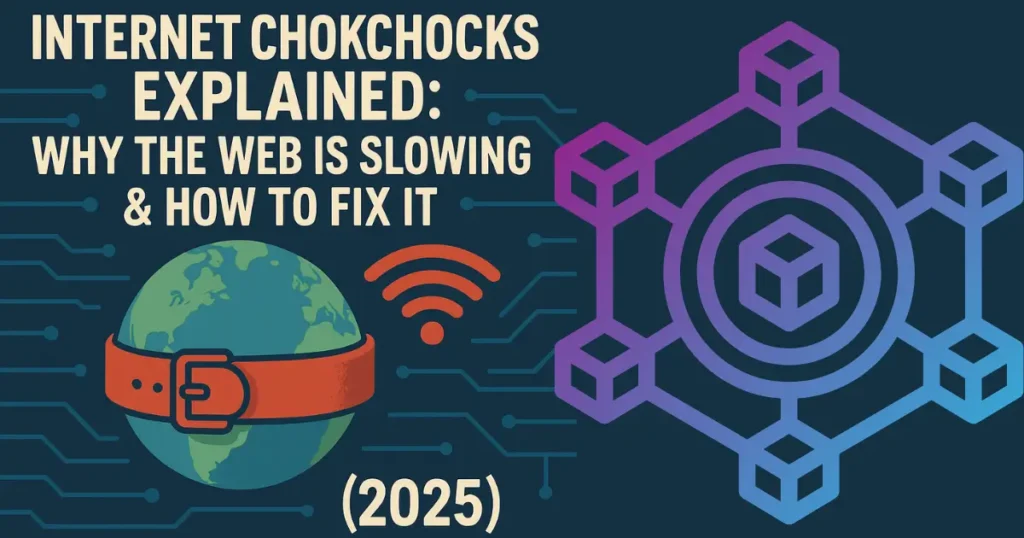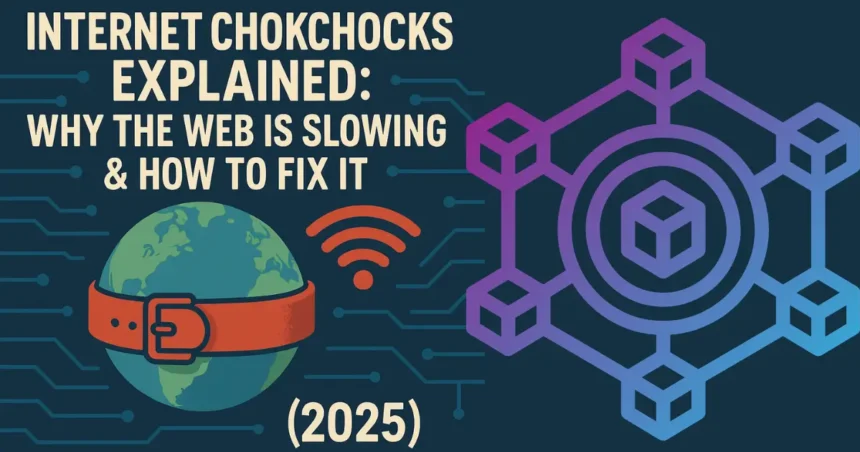
“Internetchocks” is a rising internet-era keyword referring to unexpected digital roadblocks or bottlenecks in web traffic flow, application responsiveness, or streaming responsiveness due to infrastructure congestion, misconfigured services, or cyber interference.
These aren’t mere “lags.” InternetChocks are systemic, and millions of users are affected unknowingly daily through mobile apps, browsers, smart TVs, and IoT devices.
The Origin and Rise of the Term
Though the phrase “internetchocks” sounds like something out of a meme forum, it started gaining traction in late 2023 after being used in several Reddit threads and GitHub issue trackers dealing with:
- ISP throttling
- Net-neutrality debates
- Cloudflare outages
- Video call drops
By 2024, cybersecurity experts and infrastructure monitoring companies began referencing “internetchocks” in whitepapers, describing symptoms of packet chokeholds, instability in CDN endpoints, and API input/output die-offs.
How InternetChocks Affect Your Online Experience
Real-World Effects in 2025
You might be wondering: Are internetchocks just slow Wi-Fi problems?
Not exactly.
They manifest like this:
| Symptom | Apparent Cause | What’s Really Happening |
|---|---|---|
| YouTube buffering at 720p | “Bad internet” | CDN congestion in your region |
| Zoom call drops randomly | “Bad camera” | Packet loss in WebRTC pipeline |
| Game updates fail | “Server offline?” | Auto-scaling nodes not working |
| E-commerce cart empties | “User error?” | Session ID cut short due to API throttling |
Common Systems Affected by InternetChocks
- Streaming Video (YouTube, Netflix, Twitch)
- Cloud Services (AWS Lambda, GCP, Azure Functions)
- Web Browsers (Edge, Chrome, Firefox)
- Mobile Apps (especially real-time communication apps)
- Smart Devices (Alexa, Google Nest, Apple HomeKit)
According to Cloudflare Radar, global interruptions tied to “choke patterns” have increased 25% YoY by Q2 of 2025.
Key Technical Causes of InternetChocks
So why are internetchocks happening more frequently?
1. Network Overload
Too many devices + too little bandwidth = inevitable choke.
2. API Timeout or Faulty Endpoint Routing
Services relying on external APIs (like Stripe, Google Maps) may fail mid-process if load balancers aren’t properly scaled.
3. CDN Misconfigurations
A content delivery network helps speed things up — until it doesn’t. Improper Geo DNS routing or edge caching fails can make fast sites crawl.
4. DNS Resolution Delay
DNS lookups delayed by milliseconds can compound greatly in real-time apps. Often an unnoticed source of micro-internetchocks.
5. DDoS or Packet Dampening Attacks
In 2025, malicious bots don’t just bring down servers, they slow drip traffic to create illusions of instability — triggering user exits and damaged reputations.
Internetchocks can:
- Break cart checkoutsDestroy email capture journeys
- Kill onboarding flows
- Disrupt loyalty apps on mobile
If you don’t monitor infrastructure beyond uptime… you might be operating blindly into entropy.
How to Detect, Diagnose, and Prevent InternetChocks
Tools You Can Use:
- New Relic or Datadog – Identify backend chokes
- GTMetrix / PageSpeed Insights – Optimize delivery chain
- Cloudflare Analytics – Check routing health
- Wireshark – Analyze network packet behavior
- UptimeRobot / Pingdom – Lag and jitter monitors
Developer Tips:
- Split dynamic/static content streams using subdomain routing
- Use fallback API endpoints with caching headers
- Apply Server-Side Rendering (SSR) where needed
- Integrate auto-throttle detection scripts
- Monitor Largest Contentful Paint (LCP) and First Input Delay (FID) aggressively
FAQs About InternetChocks
Q1: Is “internetchocks” an official technical term?
Not yet — but it is a rapidly evolving internet-native term validated by user search behavior and developer usage.
Q2: How do I know if I’m experiencing an internetchock vs ISP slowdown?
Use traceroute tools and check global CDN status pages. If your internet speed test looks fine but activities like file downloads or video playback stall intermittently, you may be experiencing a chokepoint.
Q3: Do VPNs help avoid internetchocks?
Sometimes. VPNs reroute your traffic, which may help bypass congested nodes — but they can also add latency depending on their own server load.
Q4: Can I monitor internetchocks on my site?
Yes. Set alerts for API response time thresholds, DNS resolve durations, and page load composition (especially third-party scripts).
Q5: Will AI help eliminate internetchocks in the future?
Absolutely. AI-enhanced ops platforms (AIOps) are playing a major role in detecting micro-latency, automating re-routing, and diagnosing infrastructure anomalies before users ever notice anything wrong.
Conclusion
InternetChocks may sound like a made-up term — but for developers, marketers, and end-users, they’re very real and extremely costly.
As the digital world continues to scale with cloud-native apps, smarter devices, and real-time syntax, even micro-lags can have macro consequences.








